In the vibrant landscapes of Arizona, diverse ecosystems flourish, each harboring an array of wildlife and unique avian wonders. Among these feathered inhabitants, a group of birds stands out for their radiant orange hues. Immerse yourself in Arizona’s dazzling world of avian diversity where orange feathers take flight against the desert backdrop.
Join us as we delve into the lives of these colorful creatures, exploring their behaviors, habitats, and the distinctive beauty they bring to the Grand Canyon State.
Orange Birds Found In Arizona
Arizona, with its diverse habitats, hosts a variety of birds, including some predominantly orange ones. With its varied topography encompassing deserts, mountains, and forests, Arizona offers a rich mosaic of habitats, nurturing an impressive diversity of bird species, including those adorned in striking orange hues.
- American Robins: They have a reddish-orange breast. Migrants or winter visitors.
- Black-headed Grosbeak: Males have an orange breast and belly. Particularly during the spring and summer.
- American Redstart: Adult males are mostly black with bright orange patches; however, it’s more of an accent than a primary color. Mostly migrants.
- Spotted Towhee: Males have a reddish-orange side, but it’s not their dominant color.
- American Kestrel: Males have a rusty-orange back and tail.
- Barn Swallow: Their underparts can range from a pale orange to a deep rust color.
- Red-breasted Nuthatch: They have a rusty-orange belly, but the color isn’t as vibrant as some other species.
- Vermilion Flycatcher: The males are bright red with a more orange hue.
- Western Tanager: Males have a bright yellow body with an orange-red head.
- Hooded Oriole: Males are bright orange with a black hood and back.
- Summer Tanager: Adult males are entirely rose-red.
- Bullock’s Oriole: Males have orange underparts and facial areas.
- Northern Cardinal: Males are bright red, not necessarily orange.
American Robins


| Feature | Measurement |
|---|---|
| Scientific Name | Leptotila plumbeicep |
| Length | 10.6-11.8 in |
| Wingspan | — |
| Weight | 160-200 g |
The American Robin is a widely recognized bird species known for its melodious song and early bird tendencies.
Appearance: American Robins are medium-sized birds with a distinctive appearance. Both males and females sport a gray to brown back and a warm red to orange breast and belly and gray wings. They also have a characteristic white eye-ring and a black head, but males are usually darker than females.
Diet: American Robins have a diverse diet that changes depending on the season. In summer, they feed heavily on earthworms, beetles, and other invertebrates, which they catch on the ground. During winter, they mostly eat fruits and berries.
Reproduction: American Robins usually build their nests in trees or shrubs, but they are also known to nest on human-made structures. The female lays a clutch of about 3 to 5 eggs, which she incubates for about 12 to 14 days.
Black-headed Grosbeak

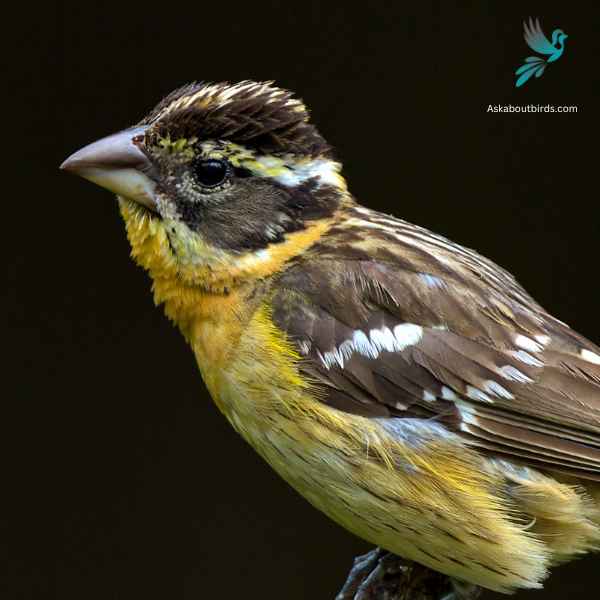
| Feature | Measurement |
|---|---|
| Scientific Name | Pheucticus melanocephalus |
| Length | 7.1–7.5 in |
| Wingspan | 12.6 in |
| Weight | 34–48 g |
The Black-headed Grosbeak is a vibrant songbird known for its melodious song, often confused with that of the American Robin but more rich and varied.
Appearance: Males are recognizable by their orange chest, black head, and black and white wings. Females, on the other hand, have a streaked brown appearance, resembling large sparrows but with hints of orange on their sides and flanks.
Diet: Black-headed Grosbeaks primarily feed on insects, seeds, and fruits. They are especially fond of beetles and caterpillars, and they’re one of the few birds that can eat monarch butterflies without suffering from the toxins.
Reproduction: They often nest in deciduous trees or shrubs. The nest is a loose, cup-like structure made from twigs and grasses. The female usually lays 3 to 4 eggs, which she incubates. Both parents share the responsibility of feeding the chicks.
American Redstart


| Feature | Measurement |
|---|---|
| Scientific Name | Setophaga ruticilla |
| Length | 4.3 to 5.5 in |
| Wingspan | 6.3 to 9.1 in |
| Weight | 8.6 g |
The American Redstart is a lively warbler known for its vivid colors and active hunting style, often seen flitting about, fanning its tail to startle and catch insects.
Appearance: Adult male American Redstarts boast striking black plumage with bright orange patches on the sides, wings, and tail. Females and immature males have grayish-olive upperparts with yellow patches in the same areas where the males display orange.
Diet: American Redstarts are primarily insectivores. They actively forage for flying insects, as well as caterpillars and spiders, often using their colorful tails to startle prey and make them easier to catch.
Reproduction: The female American Redstart builds a cup-shaped nest in the fork of a tree branch. Typically, she lays a clutch of 3 to 5 eggs. The female takes on the primary responsibility of incubating the eggs, while both parents participate in feeding the fledglings after they hatch.
Spotted Towhee

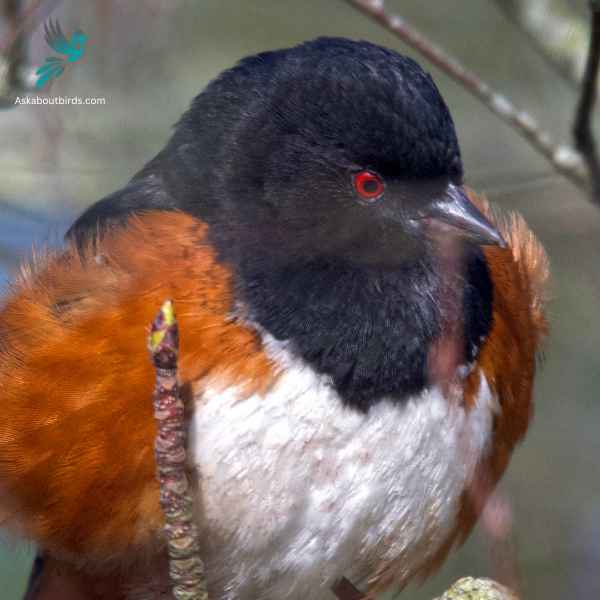
| Feature | Measurement |
|---|---|
| Scientific Name | Pipilo maculatus |
| Length | 6.7-8.3 in |
| Wingspan | 11.0 in |
| Weight | 33 g |
The Spotted Towhee is a distinctive songbird commonly found in the shrubby undergrowth and thickets of the western parts of North America. Its song, a series of melodious chirps, often punctuates the early morning air.
Appearance: Male Spotted Towhees showcase a coal-black head, throat, and upper body contrasted with rufous sides and a white belly. Their wings and back are dark but adorned with white spots, hence their name. Females have a similar pattern but are more brownish than black.
Diet: Spotted Towhees primarily feed on a mixture of insects and seeds. They often forage on the ground, scratching through leaf litter to uncover beetles, ants, and other insects, as well as various seeds and berries.
Reproduction: Spotted Towhees usually nest on the ground, concealed by dense vegetation or sometimes in low shrubs. The female builds the nest and lays a clutch of 3 to 5 eggs. She incubates the eggs, while the male stands guard and both parents partake in feeding the fledglings after hatching.
American Kestrel
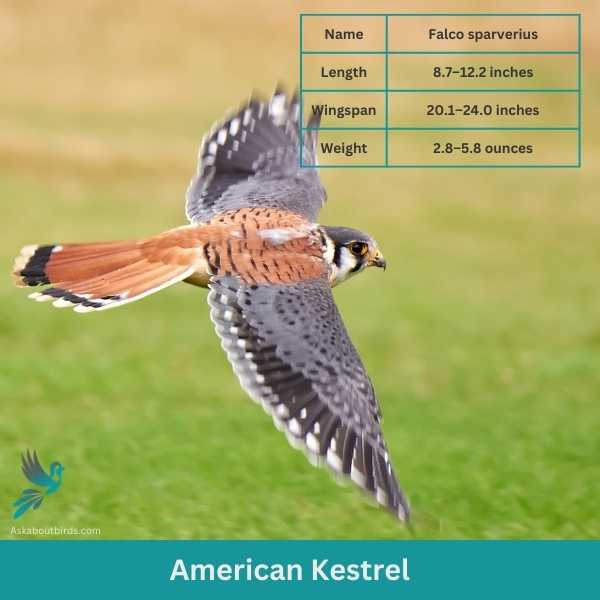

| Feature | Measurement |
|---|---|
| Scientific Name | Falco sparverius |
| Length | 8.7–12.2 inches |
| Wingspan | 20.1–24.0 inches |
| Weight | 2.8–5.8 ounces |
The American Kestrel, often referred to as the Sparrow Hawk, is the smallest and most common falcon in North America, known for its vivid coloration and speedy flight.
Appearance: The American Kestrel is a colorful bird, with males featuring a blue-grey head and wings contrasting with a rusty-orange back and tail. Females are less brightly colored but still display a similar pattern. They both have a notable black dash on their cheeks.
Diet: As opportunistic predators, American Kestrels feed on a variety of small animals, including insects, small mammals, birds, and reptiles. They have excellent eyesight that enables them to spot prey from high above, before diving down at impressive speeds to make a catch.
Reproduction: American Kestrels typically nest in cavities, often those previously made by woodpeckers. The female lays a clutch of about 4 to 5 eggs.
Barn Swallow

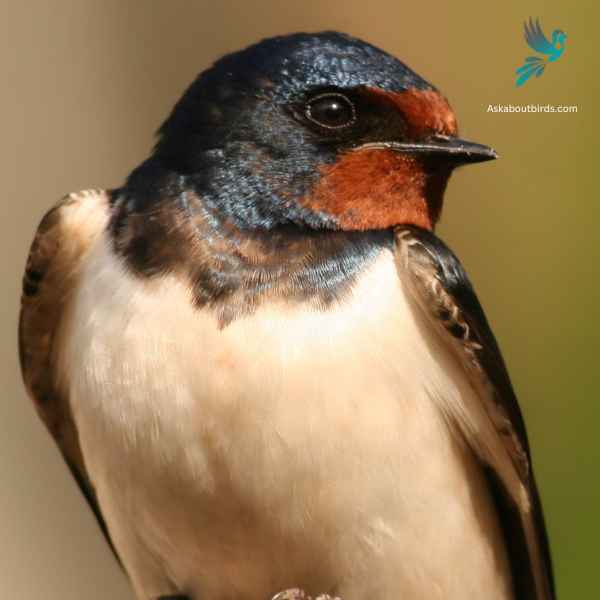
| Feature | Measurement |
|---|---|
| Scientific Name | Hirundo rustica |
| Length | 6.5–7.5 in |
| Wingspan | 12.5–13.5 in |
| Weight | 16–22 g |
The Barn Swallow is a sleek, agile bird renowned for its graceful flight patterns and iconic forked tail, often seen darting over fields and water bodies in search of flying insects.
Appearance: Barn Swallows have deep blue, almost iridescent, upperparts and a rufous to tawny underbelly. Their distinctively forked tail and long wings give them a streamlined look. Both males and females have a similar appearance, though males often exhibit slightly brighter colors and a deeper fork in the tail.
Diet: Barn Swallows feed primarily on flying insects, which they catch in mid-air during their agile and acrobatic flights. Their diet includes flies, beetles, moths, and other small flying insects.
Reproduction: Barn Swallows are known for building their mud nests on man-made structures, particularly barns, bridges, and eaves. The nest is cup-shaped and made from mud pellets, often lined with feathers. The female lays a clutch of 4 to 6 eggs.
Red-breasted Nuthatch

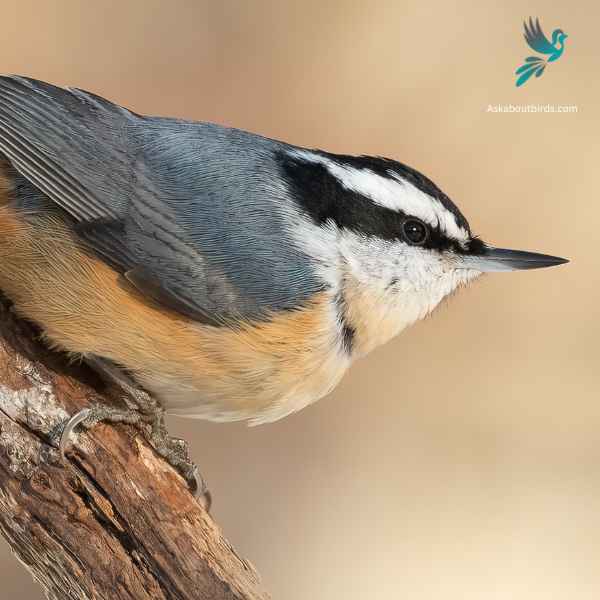
| Feature | Measurement |
|---|---|
| Scientific Name | Sitta canadensis |
| Length | 4.3–4.7 in |
| Wingspan | 8.3 in |
| Weight | 0.3–0.5 oz |
The Red-breasted Nuthatch is a small, agile songbird, known for its ability to move headfirst down tree trunks while searching for food.
Appearance: This bird boasts a slate-blue back and a pale rust-red underside. A prominent black stripe runs through the eye and is bordered above by a white eyebrow. Their sharp, pointed bill is characteristic of the species.
Diet: Red-breasted Nuthatches primarily feed on insects and seeds, especially those from coniferous trees. They have a fondness for large seeds, which they wedge into bark crevices to hack open with their bills.
Reproduction: These birds construct nests in natural tree cavities or abandoned woodpecker holes, often lining the entrance with resin. This is thought to deter predators or competitors from entering. The female typically lays a clutch of 5 to 6 eggs, and both parents partake in feeding the chicks once they hatch.
Vermilion Flycatcher
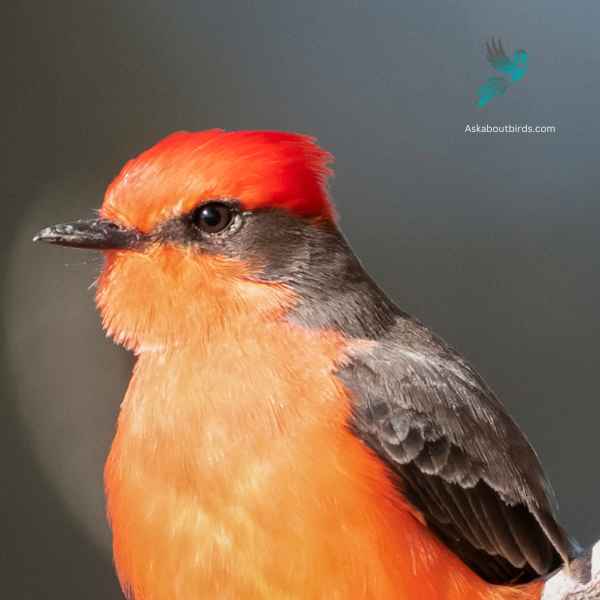

| Feature | Measurement |
|---|---|
| Scientific Name | Pyrocephalus obscurus |
| Length | 5.1–5.5 in |
| Wingspan | 9.4 to 9.8 in |
| Weight | 11 to 14 g |
The Vermilion Flycatcher is a small and colorful bird native to the Americas. The male Vermilion Flycatcher is a striking sight, displaying a vibrant red plumage on its head, breast, and underparts, contrasting with its brown wings and black tail below. Females, on the other hand, have more muted colors, featuring a pale yellowish belly and grayish-brown upperparts.
Vermilion Flycatchers are known for their lively and acrobatic flight displays, which they perform during courtship or to defend their territories. They often sing a series of soft, whistled notes while engaged in these aerial displays. They construct cup-shaped nests, usually in shrubs or low trees, where females lay their eggs and raise their young.
Western Tanager

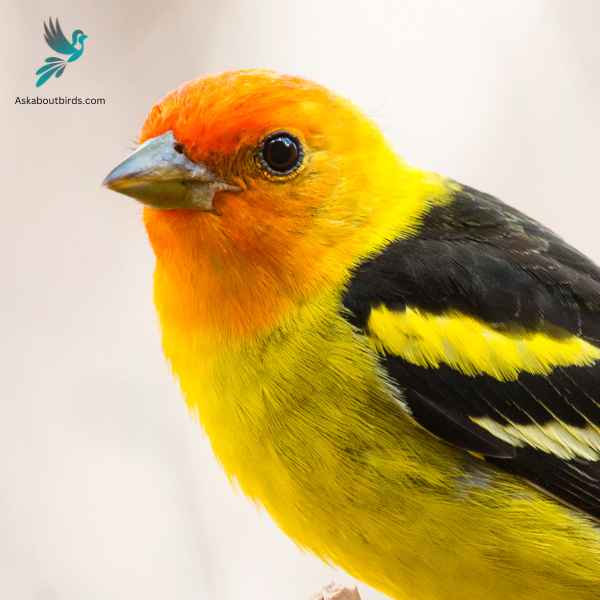
| Feature | Measurement |
|---|---|
| Scientific Name | Piranga ludoviciana |
| Length | 6.3-7.5 in |
| Wingspan | 11.5 in |
| Weight | 24-36 g |
The Western Tanager is a vibrant songbird that graces the forests and woodlands of the western regions of North America, enchanting observers with its colorful plumage and melodious song.
Appearance: The male Western Tanager is renowned for its bright yellow body contrasted with a striking red head and black wings and tail. The females are more subdued in hue, primarily being yellow with grayish wings and back, and lacking the brilliant red head of the males.
Diet: Western Tanagers primarily feed on insects, especially when breeding, but they also incorporate a significant amount of fruits and berries into their diet, especially during migration and winter.
Reproduction: Western Tanagers build their nests high in coniferous trees, often well concealed from potential predators. The female usually lays a clutch of 3 to 5 eggs and takes the primary role in incubation, while both parents are involved in feeding the chicks after they hatch.
Hooded Oriole
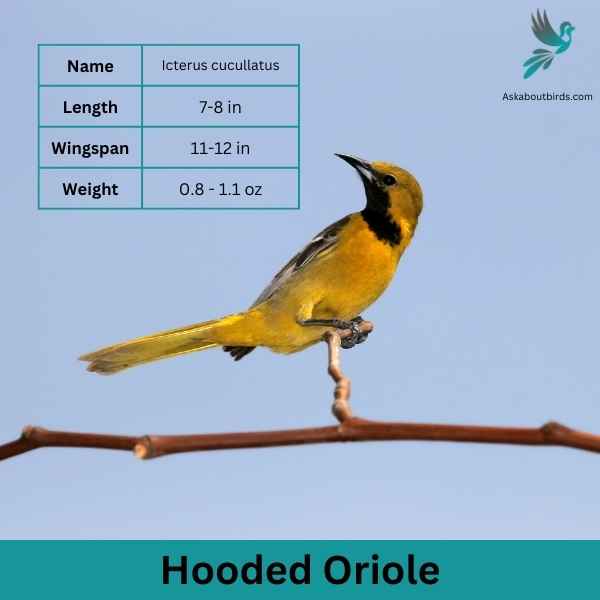

| Feature | Measurement |
|---|---|
| Scientific Name | Icterus cucullatus |
| Length | 7-8 in |
| Wingspan | 11-12 in |
| Weight | 0.8 – 1.1 oz |
The Hooded Oriole is a brightly colored bird commonly found in the southwestern United States and Mexico, recognized for its vibrant orange-yellow plumage and melodic songs.
Appearance: Males boast a deep orange body contrasted with a black bib, face, and throat, while the wings and tail are predominantly black with white wing bars. Females have a paler, yellow-green appearance, lacking the distinctive hood found in males. Both sexes have long tail feathers and a slightly curved bill.
Diet: The Hooded Oriole’s diet mainly consists of insects, nectar, and fruit. They are especially fond of the nectar from flowers and hummingbird feeders, often competing with hummingbirds for access.
Reproduction: These birds are known to use palm trees for nesting, weaving their nests to the underside of large palm fronds. The nest is a deep pouch, which offers protection to the 3-5 eggs that are typically laid. Both parents share in feeding the young after they hatch.
Summer Tanager


| Feature | Measurement |
|---|---|
| Scientific Name | Piranga rubra |
| Length | 6.7 in |
| Wingspan | 28 to 30 cm |
| Weight | 29 g |
The Summer Tanager is a medium-sized songbird admired for its radiant plumage and melodious song.
Appearance: Male Summer Tanagers are an impressive bright red, while females and juveniles present a softer, yellow-orange color. Both genders have a large, slightly hooked bill and relatively short tail.
Diet: Summer Tanagers primarily feed on insects, including bees and wasps, which they catch in flight or pick off vegetation. They are also known to eat fruits and berries, making them helpful in controlling pest populations and seed dispersal.
Reproduction: The female Summer Tanager builds a loose, shallow cup-shaped nest out of twigs and grass, usually hidden in the foliage of trees. The female typically lays 3-5 eggs, which she will incubate for about two weeks.
Bullock’s Oriole

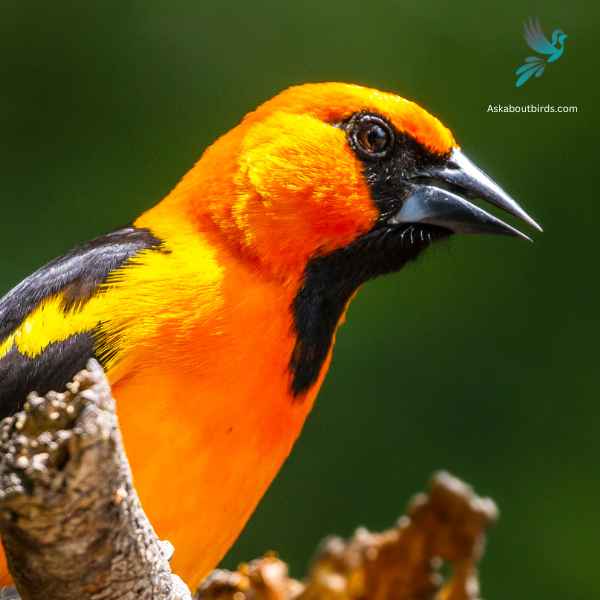
| Feature | Measurement (Imperial) |
|---|---|
| Scientific Name | Icterus bullockii |
| Length | 7.5-8.5 inches |
| Wingspan | 11.8-12.6 inches |
| Weight | 0.9-1.2 oz |
The Bullock’s Oriole is a bright and lively songbird, known for its stunning contrasting colors and vibrant melodies, predominantly found across the western regions of North America.
Appearance: The male Bullock’s Oriole boasts a brilliant orange chest, belly, and face with a black crown, eye line, throat, and back. Its wings are black with a prominent white patch and white-edged coverts. Females are more muted in coloration, displaying a yellowish-orange hue with grayish-brown wings that still retain the white patches.
Diet: These orioles primarily feed on insects, especially caterpillars, beetles, and grasshoppers. Apart from insects, their diet also includes fruits, berries, and nectar. They’re adept foragers, often hanging upside-down on branches to find hidden prey.
Reproduction: Bullock’s Orioles are noted for their skill in crafting hanging, woven nests, often positioned on the tips of slender branches, ensuring they are difficult for predators to access. Both parents partake in feeding the young, who then fledge about two weeks after hatching.
Northern Cardinal


| Feature | Measurement |
|---|---|
| Scientific Name | Cardinalis cardinalis |
| Length | 8.3 – 9.1 in |
| Wingspan | 9.8 – 12.2 in |
| Weight | 1.19 – 2.29 oz |
The Northern Cardinal is an iconic North American bird, easily recognized by its vibrant color and melodious song.
Appearance: Male Northern Cardinals are a brilliant scarlet red, while females display a more subdued reddish olive. Both sexes have a distinctive black ‘mask’ on their face around the bill and a pointed crest on their head. The bird’s beak is robust, cone-shaped, and bright orange in color.
Diet: Northern Cardinals are primarily granivorous, with a diet largely consisting of seeds and grains. They also eat fruits and insects. These birds typically feed off the ground and are frequent visitors to bird feeders.
Reproduction: Northern Cardinals are monogamous, and a pair will breed together for life. The female typically builds a well-hidden nest in a dense thicket or shrub. She lays 2-5 eggs per clutch, which she incubates for around two weeks.
Where to Spot Arizona’s Orange Birds
Arizona, graced with a wide array of ecosystems, provides a unique and fruitful landscape for birdwatchers, especially those with a keen interest in vibrant orange birds. Here are some top-rated locations that boast an impressive diversity of avian life:
- Southeastern Arizona – Recognized as one of North America’s top birding locations, this area, specifically the Sky Islands, hosts a multitude of species including the Summer Tanager and Vermilion Flycatcher.
- San Pedro River Valley – This major migratory corridor offers fantastic bird watching opportunities, with over 350 species recorded, including the striking Western Tanager.
- Canyon de Chelly National Monument – Nestled in northeastern Arizona, this region attracts birdwatchers with its variety of species, including the Northern Cardinal.
- Saguaro National Park – Famous for its towering cactus plants, this park is also a great location to spot the Bullock’s Oriole and Hooded Oriole among other species.
These notable birdwatching spots in Arizona promise not only an abundance of avian diversity but also offer striking natural beauty.
| State’s Orange Birds | Best Spots to See Orange Birds |
|---|---|
| California’s Orange Birds | 1. Point Reyes National Seashore 2. Yosemite National Park 3. San Joaquin Wildlife Sanctuary |
| Nevada’s Orange Birds | 1. Ash Meadows National Wildlife Refuge 2. Great Basin National Park 3. Red Rock Canyon National Conservation Area |
| Utah’s Orange Birds | 1. Bear River Migratory Bird Refuge 2. Zion National Park 3. Antelope Island State Park |
| Colorado’s Orange Birds | 1. Rocky Mountain National Park 2. Barr Lake State Park 3. Garden of the Gods |
| New Mexico’s Orange Birds | 1. Bosque del Apache National Wildlife Refuge 2. Carlsbad Caverns National Park 3. Río Grande Nature Center State Park |
FAQs on Orange Bird Species Found in Arizona
What bird has a bright orange chest in Arizona?
In southern Arizona, the bird known for its rusty orange breast is the Black-headed Grosbeak. These birds are often found near western red cedar and forest edges. Their contrasting black and white wings combined with that distinct chest coloration make them a captivating sight for birdwatchers.
What bird is orange in color?
Hooded orioles known for their flame orange color, is among the most vibrant yellow birds you’ll encounter. Native to areas stretching up to Central America, they can often be seen in southern Arizona. With dark gray to black hues complementing their brilliant body, they’re hard to miss.
Are scarlet tanagers in Arizona?
Scarlet Tanagers are bright red birds typically found in the eastern parts of North America. However, in Arizona, one is more likely to encounter other species, like the brilliant blue and bright yellow of certain orioles. Forest edges and western red cedars are more commonly home to birds like the Black-headed Grosbeak rather than the Scarlet Tanager.
What black bird has an orange head in Arizona?
A bird matching this description is the House Finch, which has males showcasing a burnt orange head. This hue can sometimes appear bright, contrasting against their gray wings. While not entirely black, their dark colors paired with those bright orange patches make them a distinctive sight against the backdrop of southern Arizona’s landscape.




